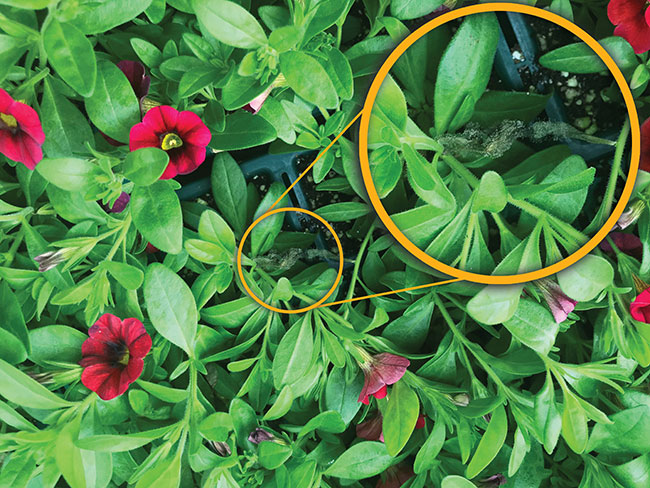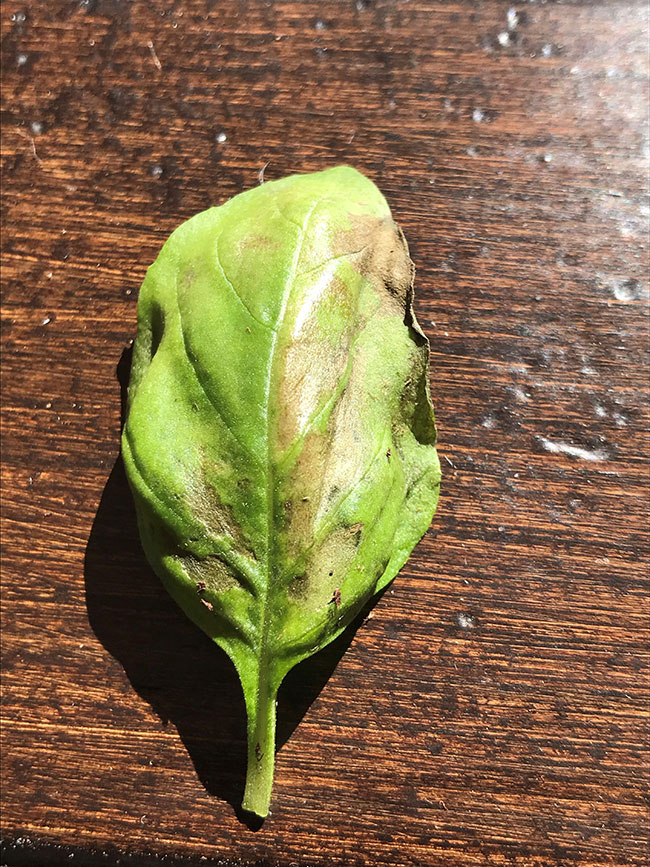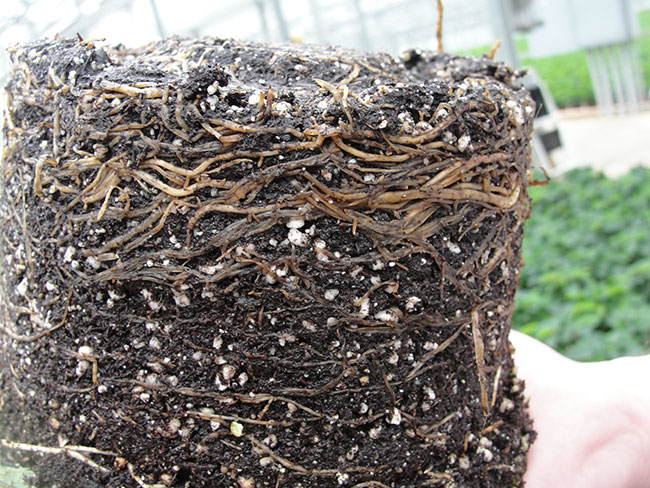
Healthy crops
While spring is in sight, cold weather can linger which means you must ensure your greenhouse operation stays free from common diseases that thrive in cooler temperatures. Creating conditions that are not conducive to disease establishment, along with recognizing the first signs of infection, are important measures to ensure diseases don’t threaten healthy crops.
BOTRYTIS
Botrytis is a common disease that can threaten greenhouse crops throughout most of the year. It can, however, be particularly problematic in the fall, winter and early spring due to the cool, cloudy and humid conditions typical during these seasons. Newly propagated material can be at a higher risk of developing botrytis, or gray mold, not only causing leaf blights but also contributing to lower stem rots in unrooted cuttings and seedlings. Transplanted crops are also at risk when plants are spaced closely on the bench. Lower light levels and higher humidity within the plant canopy makes this area prone to infections, particularly since penetration of protectant fungicides into the lower plant canopy can be a challenge.

Postharvest environments such as shipping of unrooted cuttings and finished material often have moist, humid conditions that can contribute to plant stress and lead to botrytis infections, so it is important to protect plants prior to shipping to other locations. Initial infections begin as water-soaked spots on foliage and flowers resulting in a gray, fuzzy spore mass as humid conditions continue. Once established, gray mold can quickly spread throughout the crop and production area.
Cultural tips to keep Botrytis out of your operation include:
- Maintaining a clean, dry growing environment
- Scouting frequently, particularly in the lower canopy
- Irrigating early in the day to reduce the time leaves are wet
- Providing good plant spacing and horizontal air flow
- Cleaning and sanitizing between crops
- Keeping humidity low by heating or venting
- Removing wounded and diseased plants as well as dead flowers/leaves immediately from the production area to limit spore production and spread. Be sure to place diseased plant material in bags or containers and close them prior to moving them out of the growing area to prevent further spread.
DOWNY MILDEW
If you are growing susceptible crops such as basil, impatiens, coleus and roses you should also scout frequently for downy mildew. Recognizing early signs will help preserve plant quality and health. Leaf discoloration or mottling, often within the veins, is the most common initial symptom.
Under humid conditions the pathogen will sporulate, creating a fuzzy or downy growth on the underside of the leaf, corresponding with the interveinal discoloration. When the fungus invades the plant internally, stunting, distortion and mortality can occur.

To reduce the threat of downy mildew, take similar steps as with Botrytis. Avoid conditions conducive to disease development by reducing humidity and scouting frequently to identify early signs of disease and remove diseased plants.
A fungicide targeting oomycete pathogens will be necessary to prevent and keep this disease controlled.
PYTHIUM
Protecting plants from root and stem rots caused by Pythium spp. can be a challenge, particularly during the winter and early spring, when the weather may be cloudier and greenhouse temperatures are cooler. Under these conditions, the growing media tends to stay wet longer, allowing oospores of Pythium spp. to germinate and invade wounds and tender plant tissue.
While unrooted cuttings and young seedlings in propagation areas are at risk because of frequent misting and high humidity, established plants are also at risk for losing healthy roots under these conditions.

When monitoring crops for signs of infection be sure to look for stunted plants, plants with light green or yellow foliage, damaged roots that are brown and soft, and lower stems with water-soaked tissue. In younger plants, look for collapse of young seedlings at the soil line.
Proper cultural practices to protect plants against Pythium spp. include:
- Cleaning the benches and growing area of debris and sanitizing between crops
- Elevating pots in low areas where water may pool
- Keeping the humidity low by heating or venting and providing adequate plant spacing
- Immediately removing any diseased plants from the area to limit spread
POWDERY MILDEW
Although powdery mildew is typically a problem in late spring and early summer, it can also be an issue on some greenhouse crops grown in the cooler months such as pansies and roses.
This pathogen can be aggressive, attacking new growth including buds, shoots, flowers and leaves. Powdery mildew fungi form white, talcum-like spots called “colonies” on leaves, stems and flowers.
Over time, these colonies increase in size and number to cover the plant’s surface. If not controlled, severe infections will cause leaves to turn yellow, brown and then drop, resulting in reduced plant vigor and growth. While powdery mildew is often first observed on the upper surface of the leaves, both sides may develop colonies, so it is important to check both sides of the leaf when scouting.
In addition to keeping your growing environment clean and dry and managing humidity, help reduce the threat of powdery mildew by:
- Checking incoming plants for disease
- Scouting fully expanded leaves weekly, particularly in the lower to mid-canopy where air movement may be limited
- Using overhead irrigation to reduce the spread of powdery mildew as it washes the spores off plants
- Removing diseased plants immediately to limit spore production and spread
COMPLETE YOUR PLANT PROTECTION
Preparation is an essential part of effective disease management. While proper scouting and cultural practices are critical components of a good disease management program, the addition of plant protection products is often needed to prevent and control persistent ornamental diseases. Consider implementing a complete agronomic program, which provides a framework for rotating products such as Postiva and Mural fungicides, which feature different strengths and modes of action to maximize protection. An agronomic plan also builds in a resistance management strategy as some diseases, especially
Botrytis, are susceptible to fungicide resistance. Rotating modes of action reduces the frequency a disease is exposed to the active ingredients in your program, limiting the chance for resistance development. Syngenta experts recommend rotating products from three to four different chemistry classes for each disease you are targeting.
To help manage difficult diseases, Syngenta has developed agronomic programs complete with product recommendations, application rates, tips and more to prevent diseases that can impact crop quality.
Reduce the risk of diseases in your operation this season with regular scouting, proper cultural practices and an agronomic plan.
Learn more about agronomic programs from Syngenta at greencastonline.com/solutions.
DISCLAIMER: All photos are either the property of Syngenta or are used with permission.
© 2023 Syngenta. Important: Always read and follow label instructions. Some products may not be registered for sale or use in all states or counties and/or may have state-specific use requirements. Please check with your local extension service to ensure registration and proper use. GreenCast, Mural, Postiva and the Syngenta logo are trademarks of a Syngenta Group Company. All other trademarks are the property of their respective third-party owners.









 Video Library
Video Library 


















